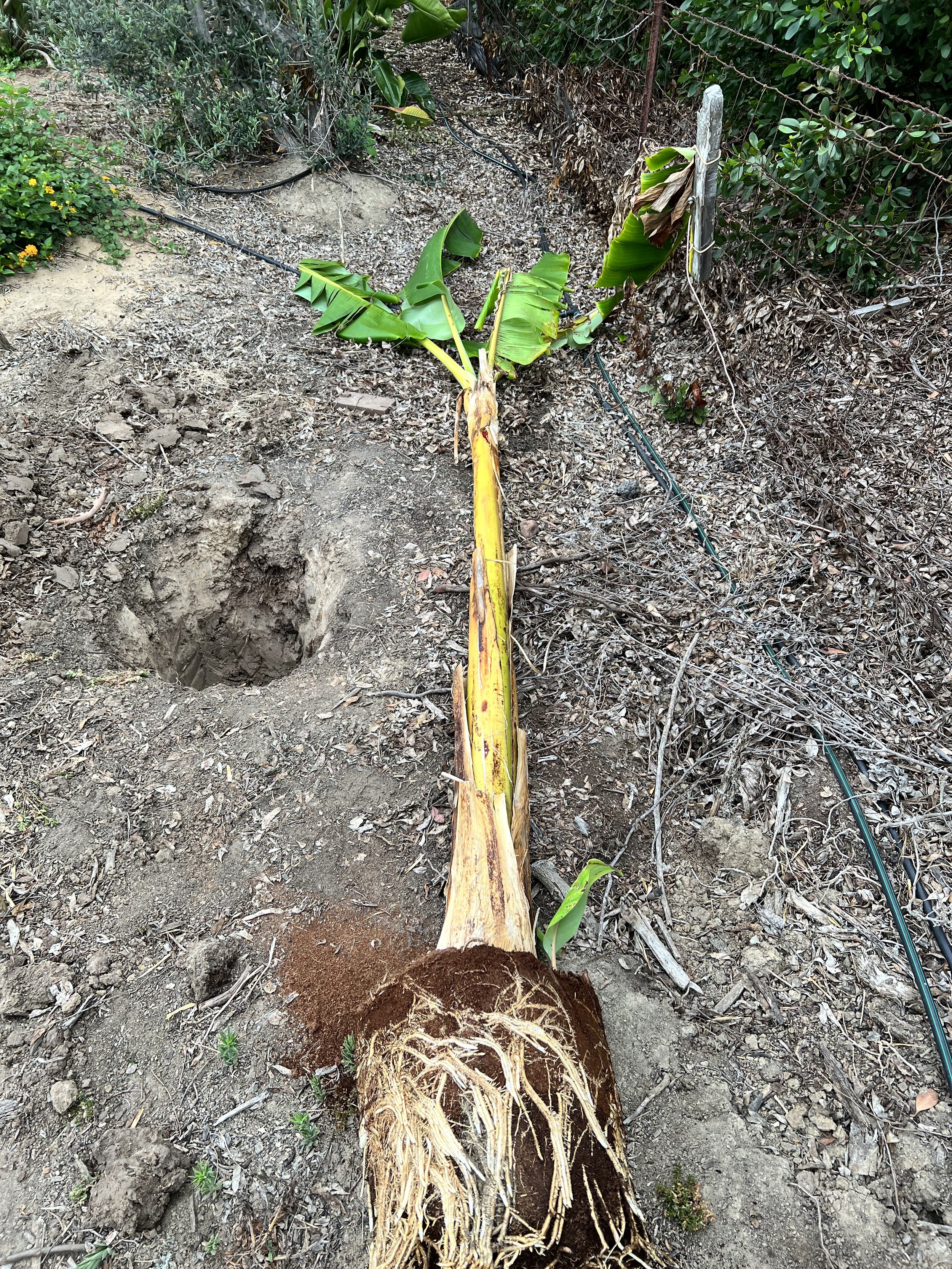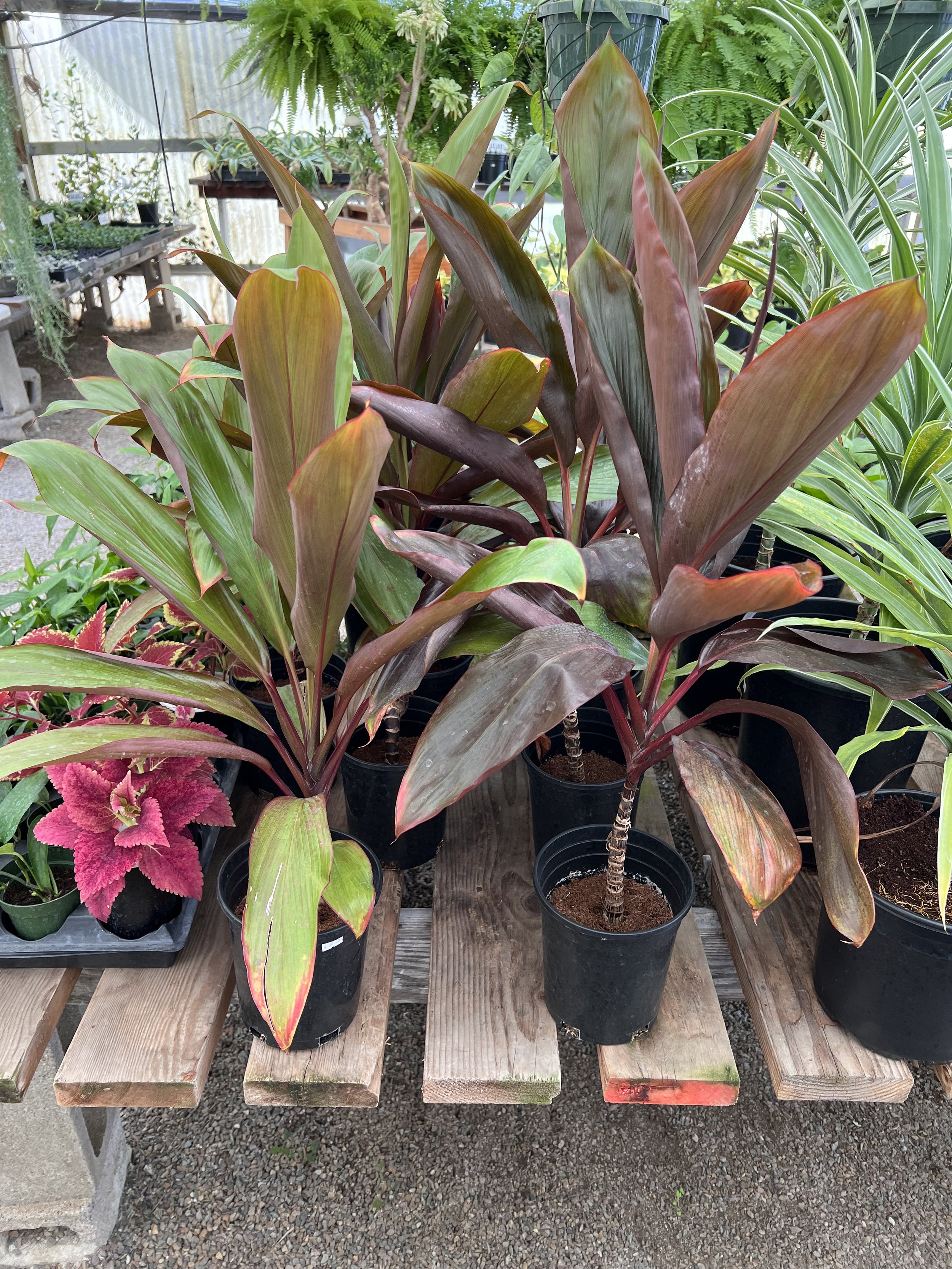Landscaping Tropical Plants
Fruiting Banana Plants (So. Cal. variety)
Available in 15 gallon nursery containers
In Southern California, Cavendish bananas are a popular choice for home gardeners due to their manageable size and delicious fruit. Here’s a brief description and care guide specifically tailored for Cavendish banana plants in this region:
Description: Cavendish bananas (Musa acuminata 'Cavendish') are medium-sized plants that typically reach heights of 6 to 10 feet. They feature large, glossy green leaves arranged in a fan-like pattern. The fruits are elongated, sweet, and usually ripen to a yellow color.
Care:
Climate and Sunlight:
Cavendish bananas thrive in full sun to partial shade. They require at least 10 hours of direct sunlight daily for optimal growth and fruiting.
Protect them from strong winds, which can damage their large leaves.
Soil:
Use well-draining, fertile soil rich in organic matter. A slightly acidic to neutral pH (around 6.5-7.0) is ideal.
Consider planting in raised beds or containers with good drainage if your soil is heavy or poorly draining.
Watering:
Keep the soil consistently moist but not waterlogged. Bananas need regular watering, especially during hot, dry periods.
Water deeply and thoroughly, ensuring the soil stays evenly moist.
Fertilization:
Fertilize regularly during the growing season (spring and summer) with a balanced fertilizer that is higher in potassium (K), such as a 8-10-8 NPK ratio, to support fruit production.
Apply fertilizer every 4-6 weeks, following manufacturer's recommendations.
Pruning and Maintenance:
Remove dead or damaged leaves regularly to improve air circulation and reduce the risk of pest and disease problems.
Trim away spent flower stalks after fruiting to encourage new growth.
Pest and Disease Control:
Keep an eye out for common pests like aphids, spider mites, and banana weevils. Treat infestations promptly with insecticidal soap or neem oil.
Prevent fungal diseases by avoiding overhead watering and maintaining good air circulation around the plant.
Harvesting:
Cavendish bananas take about 9-12 months to mature and ripen. Harvest when the fruits are fully yellow and slightly soft to the touch.
Cut the entire bunch when harvesting. Hang it in a cool, shady place to ripen further.
By following these care guidelines, you can successfully grow Cavendish banana plants in Southern California, enjoying fresh bananas from your own garden.
Canna Lilys
Available for sale in 1 and 2 gallon nursery containers.
Canna lilies (Canna spp.) are known for their vibrant and exotic-looking flowers, which come in a variety of colors including red, orange, yellow, and pink. They are characterized by their large, paddle-shaped leaves that may be green or variegated. Canna plants can range in height from 1 to 8 feet tall, depending on the variety and growing conditions. They are commonly grown for their ornamental appeal and tropical aesthetic.
Care:
Sunlight:
Canna lilies thrive in full sun to partial shade. They prefer at least 6-8 hours of direct sunlight daily for best growth and flowering.
Soil:
Plant canna lilies in well-draining, fertile soil that is rich in organic matter. They prefer slightly acidic to neutral soil (pH 6.0-7.0).
Watering:
Keep the soil consistently moist during the growing season, especially during hot weather. Water deeply, but allow the soil to dry slightly between waterings.
Fertilization:
Feed canna lilies with a balanced fertilizer (such as 10-10-10) during the growing season to encourage blooming. Follow the manufacturer's recommendations for application rates.
Mulching:
Apply a layer of mulch around the base of the plants to retain moisture and suppress weeds. This is especially beneficial in warmer climates.
Pruning:
Remove spent flowers and yellowing leaves to improve the plant's appearance and encourage continuous blooming.
Pest and Disease Control:
Keep an eye out for common pests such as aphids, caterpillars, and spider mites. Treat infestations promptly with insecticidal soap or neem oil.
Canna lilies are generally resistant to diseases, but good air circulation can help prevent fungal issues.
Propagation:
Divide mature clumps of canna lilies every few years in spring. Ensure each division has healthy rhizomes and shoots for successful transplanting.
By following these care tips, you can enjoy the lush foliage and vibrant flowers of canna lilies in your garden or landscape. They are relatively low-maintenance plants that thrive in warm climates, adding a tropical flair to outdoor spaces.
Plumerias
All available in 1 gallon to 3 gallon pot sizes
Many people are surprised to learn these tropical blooming plants are actually succulents. They make wonderful patio plants, bloom during the summer months and most varieties are very fragrant.
Care: Plumerias should be located where they can receive a good amount of sunlight and a good amount of heat (but avoid placing them in areas that will reach temperatures in the 90's(F) and above. Water every 5 to 7 days thoroughly, and make sure that the plant drains well. A good soil mixture should contain equal part pearlite to potting soil mix, less pearlite can be used with rapid draining soils (COIR potting mix works well, available at our store). Plumerias will go dormant in the colder months, the leaves will turn yellow and begin to drop. During this time, they will only need a minimal amount of water.
Ti Plants
Ti plants, also known as Cordyline fruticosa or Hawaiian ti plant, are popular ornamental plants native to Southeast Asia, Australia, and the Pacific Islands. They are characterized by their vibrant, glossy leaves that can range in color from green to various shades of red, pink, purple, yellow, or variegated patterns. Ti plants can grow both indoors and outdoors in warm climates, reaching heights of up to several feet depending on the variety.
These plants are appreciated for their tropical appearance and are often used as decorative accents in gardens, landscapes, and indoor spaces. They thrive in well-draining soil and prefer bright, indirect light. Ti plants are relatively low-maintenance, requiring occasional watering and periodically pruning to maintain their shape and appearance. They are also known for their air-purifying qualities, making them a popular choice for indoor environments.
We currently offer the standard Ti plants, as well as red, and green leaf varieties. Sold in 1 gallon to 5 gallon container sizes.


























